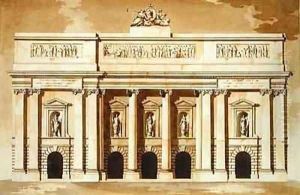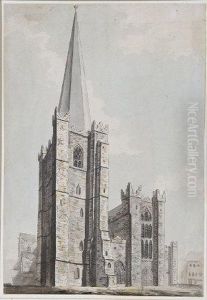James Gandon Paintings
James Gandon, born on February 20, 1743, in London, England, is a name of paramount importance in the annals of Irish architecture. His work, primarily during the late 18th and early 19th centuries, left an indelible mark on the architectural landscape of Ireland, particularly in Dublin. Gandon, the son of a French Huguenot father and an English mother, showed early promise in the field of design, which led to his education at Shipley's Drawing School where he honed his skills and later, his apprenticeship with Sir William Chambers, a leading architect of the time. This period was crucial in shaping Gandon's classical design sensibilities and his understanding of public and monumental architecture.
In 1781, at the age of 38, Gandon moved to Ireland, a move that would commence the most influential period of his career. This relocation was prompted by his commission to design the new Custom House in Dublin, a project that came to him through the influence of his friend, Charles Jenkinson, the 1st Earl of Liverpool. The Custom House is often considered Gandon's masterpiece, showcasing his adeptness at integrating functionality with grandeur, all the while employing the neoclassical style that defines much of his work. Despite facing opposition and hostility from certain sections of Dublin society during its construction, the Custom House was completed in 1791 and stands today as a testament to Gandon's vision and skill.
Gandon's contributions to Dublin's cityscape did not end with the Custom House. He was also the architect behind other significant structures such as the Four Courts, the King's Inns, and the renovation of Leinster House. Each of these projects further cemented his reputation as a master of neoclassical architecture, characterized by a keen attention to detail, a profound understanding of classical principles, and the ability to adapt these to the needs and aesthetics of his time.
Despite his considerable contributions to the architectural heritage of Ireland, Gandon never fully settled into life in Dublin, often facing criticism from those who viewed him as an outsider. Nevertheless, his works have endured, celebrated for their beauty, functionality, and historical significance. James Gandon passed away on December 14, 1823, in Lucan, County Dublin, Ireland. His legacy is preserved not only in the buildings he designed but also in the influence he exerted on the generations of architects that followed. Gandon's work remains a pivotal chapter in the story of Irish architecture, a bridge between the classical traditions of the past and the evolving architectural narratives of his time.

